The Rock Cycle
Interactive Video The Rock Cycle in Action Song
The Rock Cycle Never STOPS!
I


Interactive Video The Rock Cycle in Action Song
The Rock Cycle Never STOPS!
I

Types of Rocks
Rocks are not all the same!
The three main types, or classes, of rock are sedimentary, metamorphic, andigneous and the differences among them have to do with how they are formed.
Sedimentary
Sedimentary rocks are formed from particles of sand, shells, pebbles, and other fragments of material. Together, all these particles are called sediment. Gradually, the sediment accumulates in layers and over a long period of time hardens into rock. Generally, sedimentary rock is fairly soft and may break apart or crumble easily. You can often see sand, pebbles, or stones in the rock, and it is usually the only type that contains fossils.
Examples of this rock type include conglomerate and limestone.
Metamorphic
Metamorphic rocks are formed under the surface of the earth from the metamorphosis (change) that occurs due to intense heat and pressure (squeezing). The rocks that result from these processes often have ribbon like layers and may have shiny crystals, formed by minerals growing slowly over time, on their surface.
Examples of this rock type include gneiss and marble.
Igneous
Igneous rocks are formed when magma (molten rock deep within the earth) cools and hardens. Sometimes the magma cools inside the earth, and other times it erupts onto the surface from volcanoes (in this case, it is called lava). When lava cools very quickly, no crystals form and the rock looks shiny and glass like. Sometimes gas bubbles are trapped in the rock during the cooling process, leaving tiny holes and spaces in the rock.
Examples of this rock type include basalt and obsidian.
Sedimentary
Sedimentary rocks are formed from particles of sand, shells, pebbles, and other fragments of material. Together, all these particles are called sediment. Gradually, the sediment accumulates in layers and over a long period of time hardens into rock. Generally, sedimentary rock is fairly soft and may break apart or crumble easily. You can often see sand, pebbles, or stones in the rock, and it is usually the only type that contains fossils.
Examples of this rock type include conglomerate and limestone.
Metamorphic
Metamorphic rocks are formed under the surface of the earth from the metamorphosis (change) that occurs due to intense heat and pressure (squeezing). The rocks that result from these processes often have ribbon like layers and may have shiny crystals, formed by minerals growing slowly over time, on their surface.
Examples of this rock type include gneiss and marble.
Igneous
Igneous rocks are formed when magma (molten rock deep within the earth) cools and hardens. Sometimes the magma cools inside the earth, and other times it erupts onto the surface from volcanoes (in this case, it is called lava). When lava cools very quickly, no crystals form and the rock looks shiny and glass like. Sometimes gas bubbles are trapped in the rock during the cooling process, leaving tiny holes and spaces in the rock.
Examples of this rock type include basalt and obsidian.
Earth's Rock cycle in Action

When Earth's tectonic plates move around, they produce heat. When they collide, they build mountains and metamorphose (met-ah-MORE-foes) the rock.
The rock cycle continues.
Mountains made of metamorphic rocks can be broken up and washed away by streams. New sediments from these mountains can make new sedimentary rock.
The rock cycle never stops. More Info
No comments:
Post a Comment